F. Michael Byrnes leaves a lasting legacy: A testimonial
Reflections on the life of nationally renowned scholastic running coach, pioneer, NSAF Co-Founder
Francis Michael “Mike” Byrnes, a renowned athletic coach in U.S. scholastic cross country and track & field circles for more than 50 years, died Dec. 26 at his home in Culpeper, Va. He was 83. The cause was complications resulting from esophageal cancer.
Mr. Byrnes was widely acknowledged to be one of the nation’s most respected high school running coaches during a career that began at New York’s Wantagh High School in 1957. Two of the athletes he coached in high school later represented the United States in the Olympic Games.
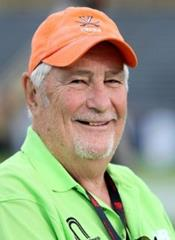
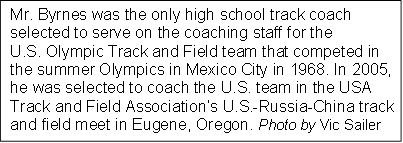
Many of his high school male and female athletes achieved all-state and all-American honors during his coaching career. His cross country and track & field teams were also consistently formidable competitors. As recently as last February, Mrs. Sarah Bowman Brown’s distance-medley relay team set an indoor world record in the New Balance Grand Prix in Boston. Mr. Byrnes began coaching Mrs. Brown during her junior year at Fauquier High School, Va. in 2004.
A Pioneering Role
Coach Byrnes expected total commitment from his athletes, but he was no less devoted to their academic and athletic development. While still teaching junior high school social studies and coaching his high school teams in Wantagh, he also played a pioneering role in expanding opportunities for young male and female athletes on Long Island to compete at regional and national levels. Eventually, this had a revolutionary effect in inter-scholastic track and field circles.
Mr. Byrnes formed the Long Island Striders (later the Long Island Athletic Club) in 1964 to provide high school and college track and field athletes an opportunity to compete during their off-season summer months. The club prospered in the years that followed.
Mr. Ron Davis, a member of the San Jose State University cross country squad that won the NCAA championship in 1962, recalled when he met Mr. Byrnes for the first time. “I had made the USA Olympic finals in the 3000m Steeplechase,” Mr. Davis said recently. “There were two U.S. Olympic Trials in 1964, and I was looking for a meet to run in. I called Mike who was hosting an All Comers Meet when I was training in Jamaica, New York, that summer. He did not hesitate to invite me to the meet. We connected that summer as I ran with the Long Island Striders.”
“Mike was encouraging to me that summer, but more than anything he connected with my family in such a way. I never had a coach develop such a closeness with my mother.”
Named the San Jose State Spartans’ head cross country coach in 2012, Mr. Davis’ track and cross country coaching career has spanned more than 40 years, including training runners in 11 countries. He founded the “I Train in LaGrange” program in Georgia in 1992. The program brought more than 500 athletes from 45 nations to Georgia before the 1996 Olympic Games in Atlanta—the largest pre-Olympic training camp in the history of the Olympic Games.
“I will miss Mike,” Mr. Davis said. “He was always there for me assisting with suggestions my Olympic training camp. Mike had a full life, but I will never forget how he contributed so much to the I Train in LaGrange program’s success.”
Mr. Byrnes and Mr. James Spier initiated "The LIAC Meet of Champions" on Long Island in the early 1970. "At the time," Mr. Spier explained, "the public, private, and Catholic schools were not allowed to compete against each other. Mike took the lead, and I created the format so that this new opportunity for wider competition could happen."
As the LIAC's membership and popularity increased, the club soon began to win multiple championships in the National Amateur Athletic Union’s junior team competitions. “It reaches into every community,” Mr. Byrnes told the newspaper Newsday at the time. “We have college kids, and we have working kids. I got a kid a scholarship the other day, and he’d been out of high school a year working in a factory. That’s why this thing is so important to me.”
Mr. Byrnes renewed his collaboration with Mr. Spier during the early 1980s at the time Mr. Tracy Sundlun began to transform the Metropolitan Athletics Congress. The "MAC" was the New York City branch of the USA Track and Field organization, the U.S. national governing body for track and field, long-distance running, and race walking in the United States. "The MAC would eventually put on 70 track and field meets annually in the New York City metropolitan area," Mr. Spier said.
When Mr. Sundlun decided to create the first national high school indoor track meet in 1984, Mr. Byrnes and Mr. Spier joined forces with him to ensure it would be a success. "I told Tracy that I could create a 'hit list' of the best U.S. athletes to recruit," said Mr. Spier, "but we needed a salesman to recruit them. Mike Byrnes was that man."
The National Scholastic Indoor Track and Field Championship was the first meet to offer travel-expense reimbursement to high school athletes. Mr. Byrnes and Mr. Spier became the meet's assistant directors for the next 13 years. When Mr. Sundlun joined the Elite Racing in 1998, the two became the indoor meet's co-directors of what was, by that time, the Nike Indoor Classic.
Taking High School Track and Field to the Highest Levels
In 1989, Mr. Byrnes and Mr. Spier established the National Scholastic Athletics Foundation (NSAF, originally named the National Scholastic Sports Foundation). The non-profit, tax-exempt foundation was created to generate funds for junior athletes who could not otherwise afford travel expenses to participate in major national and international track-and-field competitions. In so doing, the foundation sought to develop high school track and field to the highest level.
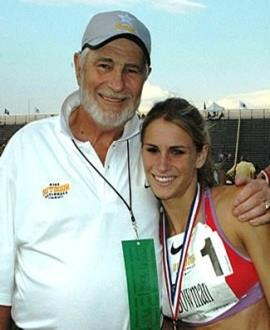
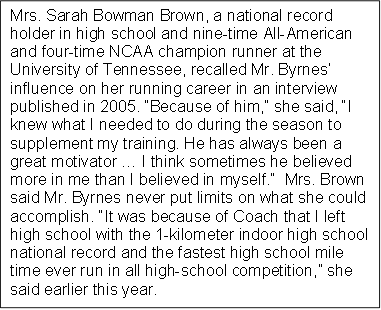
Funds for athletes’ travel were raised initially from membership dues and the publication of Track Digest. Mr. Byrnes was the publication’s primary editor. As noted in the Foundation’s history, “All of the work done by Spier and Byrnes was done on a voluntary basis with the ‘up-front’ money necessary to found the foundation funded by them as well.”
In 1991, the Birmingham High School Dads Club in California approached the NSAF to run a de facto national high school outdoor championship meet with a budget to recruit athletes. Again, Mr. Byrnes did all of the recruiting for that meet and those that followed in California and North Carolina. The nation's top high school athletes competed.
"It was mainly a two-man show in the early years, with Mike, me, and our wives running the meets," Mr. Spier recalled. "Little by little, we added staff. As the meets grew, we finally brought in enough money to make a serious impact on helping athletes to attend junior championships. None of this could have been done without Mike. He was the soul of the organization for all those years."
Mr. Steve Underwood, the director of media and public relations for the NSAF, well remembers the 2006 Nike Indoor Nationals at the Prince George’s Sportsplex in Hyattsville, Md.:
“The boys' and girls' mile races had just finished—good, but not overwhelming races. It seemed like much of the crowd was still dwelling on those finishes, and we media were talking with those winners, when the girls' 400 meters went off. It wasn't until the first lap was completed that many of us realized sprint queen Francena McCorory, then a Bethel, Virginia, senior, was obliterating the field and on her way to crushing the national record.
“By the time she crossed the line in 51.93—the old record having been Sanya Richards' 52.10 on the faster, banked surface of The Armory—the crowd was roaring and, well, pretty much realizing what they had just witnessed. But I remember this slightly gnawing sense that folks may not have realized just how incredible Francena's run had been.
“Then Mike Byrnes stepped forward. Basically stopping the meet in its tracks for several minutes, Mr. Byrnes spontaneously took to the microphone, addressed the crowd, and made sure everyone truly realized the historic magnificence of the run. ‘This was the greatest high school performance I have ever seen,’ he proclaimed, and did a quick interview with Francena.
“It was an epic performance by the future Olympian, but immortalized—if you will—for everyone by Mike. There are times in our sport when that kind of initiative is imperative, and that was one of those times. Mike seemed totally in his element there, doing what was perfectly natural to him and greatly enhancing the magnitude of the moment. It wasn't the first time he stepped forward like that—and it was one of the many reasons why NSAF meets are so great.
“I'll never forget that afternoon. It remains one of my strongest memories of the sport. No one has come close to Francena's record in nearly 10 years, and I would not be surprised if Mike still felt it was the greatest performance he'd ever witnessed. It would sure be right up there for me.”
The national indoor and outdoor track and field national championship meets continue to the present day as the New Balance Indoor National Championships and the New Balance Outdoor National Championships each March and June, respectively, and the Great American Cross Country Festival each autumn.
From a total of 500 athletes who competed in the first outdoor championship in 1991, more than 10,000 athletes from across the country competed in the Foundation's sponsored meets, cross country competitions, and two national championships in 2014. Since 1991, Mr. Spier said, the National Scholastic Athletics Foundation has raised more than $2.7 million to put on its competitions and assist junior athletes compete at the national and international levels.
The New Balance championship meets have grown into two of the premier scholastic track-and-field sporting events in the country. The 2014 and 2015 indoor contests are considered by some track enthusiasts to be the best high-school indoor meets ever, with seven national records set at this year’s event at New York City’s “The Armory” National Track & Field Hall of Fame facility. Since the 1992 Olympic Summer Games, the foundation estimates that more than half of the members on the U.S. track and field teams have competed in the Indoor or Outdoor National Championships.
Writing about the foundation’s work and the sponsorship provided by Nike and, later, New Balance, Mr. Byrnes observed in 2007, “Together we have done something spectacular. We have changed the face of track and field in our nation.”
To honor Mr. Byrnes' distinguished coaching career and the pioneering role that he played in establishing the foundation and helping to create the national championship meets, the NSAF bestows its “Mike Byrnes Coach of the Year” award annually to the most-deserving high school track and field coach in the country.
Mr. Byrnes also had a long-standing association with the Penn Relays in Philadelphia, the oldest and largest track and field competition in the United States. During the years he coached track at Wantagh High School, his teams competed regularly. After he co-founded the NSAF, Mr. Byrnes and other members of the foundation traveled to Philadelphia to assist the event’s support staff by timing each relay runner’s splits. Mr. Byrnes and Mr. Spier were each named honorary “High School Meet Referees” for their many years of assistance.
A Lifelong Determination to Learn
Francis Michael Byrnes was born March 27, 1932, in Philadelphia, Penn., to the late Francis T. Byrnes and the late Marion Brown. He grew up in Richmond, Va., where he was a member of John Marshall High School’s track team. During his senior year, he was one of the top milers in Virginia. He demonstrated a lifelong determination to learn as much as possible about running and coaching.
When he was 18, Mr. Byrnes wrote several prominent track coaches to obtain their training recommendations, including Sweden’s Gustaf Holmer, an Olympic athlete and coach who developed the “fartlek” method of interval training. Replying from Stockholm in February, 1951, Mr. Holmer sent Mr. Byrnes a weekly training schedule. “I think 2-3 miles will be your best distance,” he wrote. “You are 18-years old only, and my opinion is that boys in [these] years at first must build up the bodypower.”
A 1953 graduate of the University of Virginia, Mr. Byrnes captained the school’s varsity cross country team during his sophomore, junior and senior years. Enlistment and service in the U.S. Army followed at Fort Bragg, N.C., where he coached his battalion’s football, basketball, and track teams.
Mr. Byrnes was a man of many talents. At various times during his decades-long teaching and coaching careers, he was also a newspaper sports reporter for Newsday, a prolific writer for track-and-field publications, owner of an athletic supply store, and lecturer.
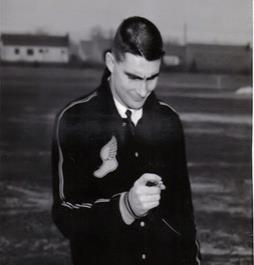
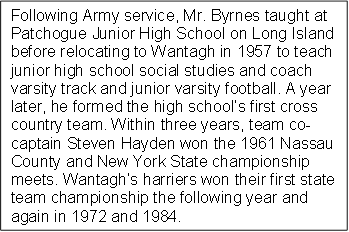
Wantagh’s reputation as a cross-country powerhouse grew as its teams went undefeated year after year and won individual and team championships at the county and state level. Mr. Byrnes’ indoor and outdoor track and field teams soon enjoyed similar success. He established a junior high school cross country team in 1962 to serve as a “farm team” for the varsity; it won Nassau County’s junior high championship in 1962 and 1963.
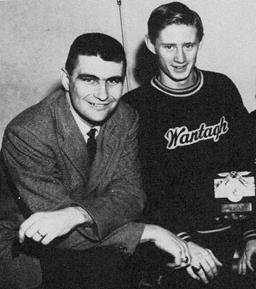
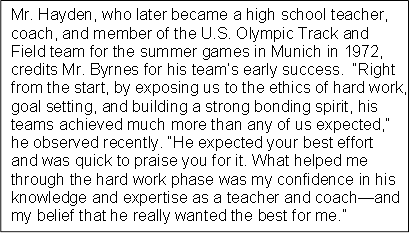
Mr. Daniel O’Connor, a 1970 graduate of Wantagh High School, also went on to become a member of the U.S. Olympic track and field teams in 1980 and 1984. “Coach Byrnes helped direct so many of us in a positive direction,” Mr. O’Connor reflected. “He always believed we could come through so many challenges if we just believed. Personally, he drove me from being a novice to runner-up in the 1969 New York State cross country championship and gave me the confidence to push myself to the next level of qualifying for two Olympic teams. He will be sorely missed by all he coached.”
The Coach
In a 2007 essay titled The Coach, Mr. Byrnes wrote that communicating with his athletes was the most important facet of coaching. “As I slowly learned my craft,” Byrnes wrote, “my athletes got better and better. They sensed how much I cared about them—not just as athletes, but also as people. Anyone who aspires to be a good coach must have this quality—a sincere caring for his or her kids.” His athletes also fondly recall his rich sense of humor.
While developing a young person’s athletic ability, Mr. Byrnes also sought to inspire a will to win. He fostered such traits as self-confidence, leadership, a capacity for hard work, a commitment to high-quality workouts, and the ability to set performance goals one can achieve over time. He developed race plans for his runners before every competition. “When you go into a race, there has to be a race plan,” he wrote. “How do you intend running the race? How do you intend reacting to changing situations? How do you expect your race to develop? What changes will you make should totally unexpected changes occur?”
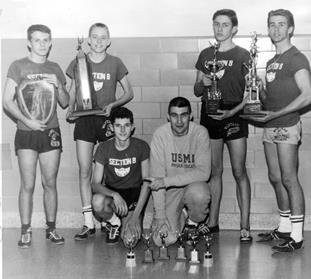
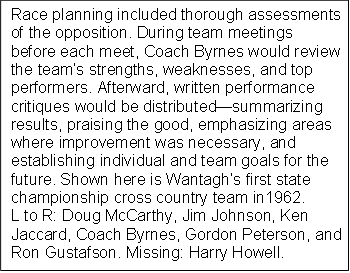
Much of his success as a coach was attributed to his ability to develop a runner’s self-motivation to improve to their full potential. “This takes constant reinforcement so they can believe in themselves—so they can visualize themselves running at a higher level,” he said. Every season, Mr. Byrnes would reinforce his verbal coaching in letters and memoranda to his athletes. “It is amazing what the human mechanism can do when you believe in yourself,” he wrote in one letter describing the body’s physiological reaction to fatigue (and how a well-conditioned athlete can counter it both physically and mentally).
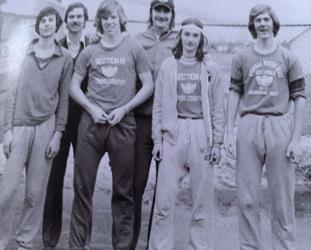
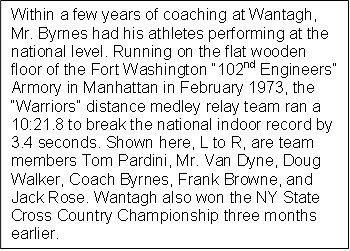
Less naturally talented athletes also benefited from his coaching. They learned that they could excel if they were committed, gave their best effort, and followed his training regimen. "If a kid came out every day and busted his hump, he got a letter. It didn't matter how good he was, but how hard he tried," Mr. Byrnes told a reporter for Newsday.
His athletes learned the importance of team performance. In cross country, for example, he stressed that the team’s fifth scoring runner was just as important as the first—as were those teammates who were trying to become a scoring runner.
“Through his actions,” said Mr. Ted Bellis, a stellar runner at Wantagh during the late 1960s, “Mr. Byrnes demonstrated that he cared about you personally, whether you were the fastest or the slowest member of the team—as long as you made an honest effort to reach your goals. By so doing, he showed the importance of believing in each team member individually while simultaneously making them feel an integral part of something larger and greater than themselves.”
Mr. Ronald Gustafson was a standout distance runner at Wantagh High School during the 1960s and later at the University of Houston. At Wantagh, he was a repeat county and state champion in cross country and the 2 mile run. He set a state record of 9:24.6 in the 2 mile in 1965, the same year he won the 2 mile at the Penn Relays. “Coach Byrnes taught me to be tough and always persevere,” Mr. Gustafson said. “I brought that with me through my entire life. I was successful in my career owing to the winning ways he taught me.”
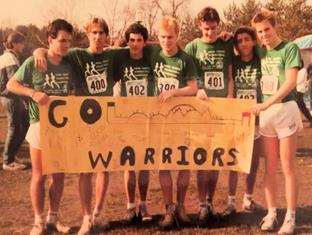
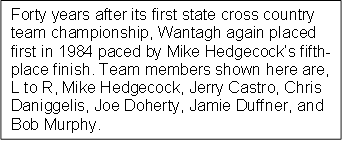
A Legacy Still Charging Forward
Mr. Byrnes approached his responsibilities in the classroom with the same dedication, enthusiasm, and preparation he displayed in his coaching. He once observed that teaching and coaching are similar in that both endeavors require students to take pride in their work if they are to be successful. He worked tirelessly to assist his athletes gain admission to college and obtain athletic scholarships for financial assistance. His example inspired any number of them to become educators and coaches themselves.
Mr. Chris Daniggelis, a 1988 graduate of Wantagh High School, was a talented distance runner in high school and at Wake Forest University. He has taught at the University of Missouri for the past 18 years .
“To date,” he said recently, “I have assisted 41 students into graduate schools with full scholarships, had one undergraduate Fulbright Scholar, and helped 12 past students land tenure-track jobs.” When his students ask how he learned to support and direct them so well, Mr. Daniggelis replies, “Coach Mike Byrnes—he helped me to help you.”
In 1985, Coach Byrnes recognized Wantagh High School’s long overdue need to field a girls’ cross country team. He jumpstarted what was to become another powerhouse running program at Wantagh. That year, Wantagh’s women’s distance-medley relay team was named to the high school All-American team and ranked first nationally by Track & Field News. That team, composed of Terri Dillingham, Gina Wills, Jennifer Antes, and Therese Devlin, also won the TAC National Scholastic Championship in the 4 x 800m relay competition.
Mrs. Therese Devlin Brown, competing in 1985 and 1986, was a two-time New York state champion in the 1500m run, was named to the U.S. All-American team, and was selected as NY state Gatorade HS Track and Field Athlete of the Year in 1986. She went on to compete for Dartmouth College where she was captain of the women’s cross country and track teams her senior year. She was named to the NCAA Division I All-American track and field team for the 3000m run during her junior season. As a post-collegiate, she competed for Adidas/Boston Athletic Association and participated in the 1992 U.S. Olympic Trials.
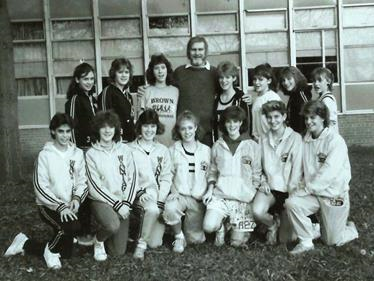
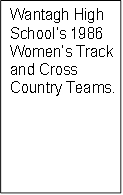
Addressing the role Mr. Byrnes played in her running career, Mrs. Brown said, “He believed in me, was so generous with his time so that I could compete in the best races, spent many frustrating moments trying to figure out how to get me to believe in myself, and gave up many evenings and weekends to help me become a better runner. In the end, he succeeded. He made me into the runner I became.”
Mrs. Brown now coaches at Villa Maria High School in Erie, Pa. Last month, her women’s varsity cross country team won the Pennsylvania Interscholastic Athletic Association’s state championship for the second year in a row. “Through Coach Byrnes’ example,” Ms. Brown related, “I have been able to pass his lessons onto countless young women here in Pennsylvania. His methods and motivational tactics are very much a part of our day-to-day activities.”
Asked to describe Mr. Byrnes’ influence on the thousands of young students and athletes he taught and coached in a career spanning more than 50 years, Mr. Daniggelis observed, “His legacy continues to charge forward in ways he can’t imagine.”
Mr. Byrnes is survived by his wife, Joan Marie Keagy Byrnes, and three sons; Richard Michael Byrnes of Warrenton, VA, D. David Pate of Tokyo, Japan, and W. Scott Pate and his wife Sharon of Oakland, CA. Additional survivors include four grandchildren, Michael Aaron Byrnes, Christina Diane Byrnes, Conner McLean Pate, and Jackson Ryder Pate. He is also survived by two sisters, Catherine B. Nelson and Mary B. Scrudato, both of Richmond, Va. In addition to his parents, he is preceded in death by a son, Stephen Christopher Byrnes.
A memorial service will be held at a later date. In lieu of flowers, the family is establishing a scholarship fund for high school track and field athletes to assist in their college tuition, to be announced when finalized. In addition, memorial donations may be made to the Reformation Lutheran Church, 415 S. Main St., Culpeper, VA 22701, and/or the Hospice of the Piedmont, 675 Peter Jefferson Pkwy, Suite 300, Charlottesville, VA 22911.
Captain Peterson, a 1964 graduate of Wantagh High School and a 1968 graduate of the U.S. Naval Academy, was a member of Coach Byrnes’ cross country, indoor, and outdoor track & field teams from 1960 to 1964. The reflections on Coach Byrnes shared by the athletes and professional colleagues quoted in this salute are gratefully acknowledged.
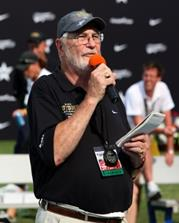
Our thanks to you, Coach




